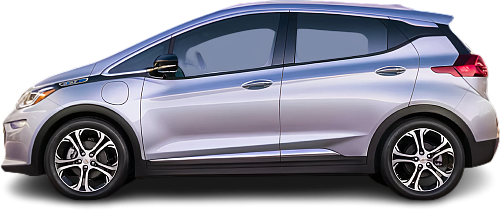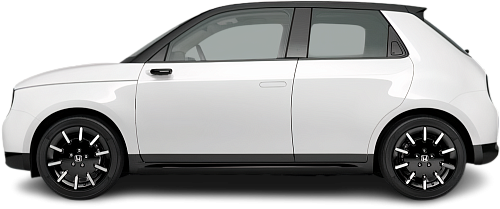USA EV Comparison: Chevrolet Bolt EV Gen 1 vs Honda e Base
Struggling to Decide? Let AI Help!
Your AI Summary Is Ready!
General Info
Since both vehicles have been discontinued, they are now only available on the used car market. You can get the Chevrolet Bolt EV Gen 1 (2017-2019) for as low as $6995, while the Honda e (2020-2022) was never offered for sale in the United States.
The two vehicles share the same body style: Hatchback.
| Property | Chevrolet Bolt EV Gen 1 | Honda e Base |
|---|---|---|
| Years of Production | 2017-2019 | 2020-2022 |
| Current Status | Discontinued | Discontinued |
| Country of Manufacture | USA | Japan |
| Body Style | Hatchback | Hatchback |
| Market Availability | USA | EU |
| Price USA (Used) | $6995 | - Price USA (Used) |
| GCC Score | 5.1 | 4.6 |
Range and Efficiency
While the Chevrolet Bolt EV Gen 1 (2017-2019) offers a longer real-world range and a bigger battery, it is less energy-efficient than the Honda e (2020-2022).
| Property | Chevrolet Bolt EV Gen 1 | Honda e Base |
|---|---|---|
| Range (EPA) | 238 mi | - Range (EPA) |
| Range (WLTP) | - Range (WLTP) | 138 mi |
| Range (GCC) | 226 mi | 117 mi |
| Battery Capacity (Nominal) | 60 kWh | 35.5 kWh |
| Battery Capacity (Usable) | 57 kWh | 28.5 kWh |
| Efficiency per 100 mi | 25.2 kWh/100 mi | 24.4 kWh/100 mi |
| Efficiency per kWh | 3.96 mi/kWh | 4.11 mi/kWh |
| Range and Efficiency Score | 7.1 | 5.8 |
Charging
Both vehicles utilize a standard 400-volt architecture.
The Chevrolet Bolt EV Gen 1 (2017-2019) offers faster charging speeds at DC stations, reaching up to 50 kW, while the Honda e (2020-2022) maxes out at 46 kW.
The Chevrolet Bolt EV Gen 1 (2017-2019) features a more powerful on-board charger, supporting a maximum AC charging power of 7.2 kW, whereas the Honda e (2020-2022) is limited to 6.6 kW.
| Property | Chevrolet Bolt EV Gen 1 | Honda e Base |
|---|---|---|
| Max Charging Power (AC) | 7.2 kW | 6.6 kW |
| Max Charging Power (DC) | 50 kW | 46 kW |
| Architecture | 400 V | 400 V |
| Charge Port | CCS Type 1 | CCS Type 2 |
| Charging Score | 4.3 | 3.6 |
Performance
The Honda e (2020-2022) is rear-wheel drive, while the Chevrolet Bolt EV Gen 1 (2017-2019) offers a front-wheel drive system.
The Chevrolet Bolt EV Gen 1 (2017-2019) boasts greater motor power and accelerates faster from 0 to 60 mph.
| Property | Chevrolet Bolt EV Gen 1 | Honda e Base |
|---|---|---|
| Drive Type | FWD | RWD |
| Motor Type | PMSM | PMSM |
| Motor Power (kW) | 150 kW | 100 kW |
| Motor Power (hp) | 201 hp | 134 hp |
| Motor Torque | 266 lb-ft | 232 lb-ft |
| 0-60 mph | 6.9 s | 8.7 s |
| Top Speed | 91 mph | 90 mph |
| Performance Score | 3.5 | 2.8 |
Dimensions
The Chevrolet Bolt EV Gen 1 (2017-2019) is longer and taller, but about the same width as the Honda e (2020-2022).
The Chevrolet Bolt EV Gen 1 (2017-2019) boasts a more extended wheelbase.
| Property | Chevrolet Bolt EV Gen 1 | Honda e Base |
|---|---|---|
| Length | 164 in | 153.3 in |
| Width (with Mirrors) | 80.3 in | - Width (with Mirrors) |
| Width (w/o Mirrors) | 69.5 in | 69 in |
| Height | 62.8 in | 59.5 in |
| Wheelbase | 102.4 in | 99.9 in |
Cargo and Towing
The Chevrolet Bolt EV Gen 1 (2017-2019) provides more cargo capacity, featuring both a larger trunk and more space with the rear seats folded.
Neither car is equipped with a frunk (front trunk).
Neither vehicle is officially rated for towing in the US.
| Property | Chevrolet Bolt EV Gen 1 | Honda e Base |
|---|---|---|
| Number of Seats | 5 | 4 |
| Curb Weight | 3580 lb | 3501 lb |
| Cargo Volume (Trunk) | 16.9 ft3 | 6 ft3 |
| Cargo Volume (Max) | 56.6 ft3 | 30.4 ft3 |
| Cargo Volume (Frunk) | - Cargo Volume (Frunk) | - Cargo Volume (Frunk) |
| Towing Capacity | - Towing Capacity | - Towing Capacity |
| Cargo and Towing Score | 4.7 | 3.8 |




